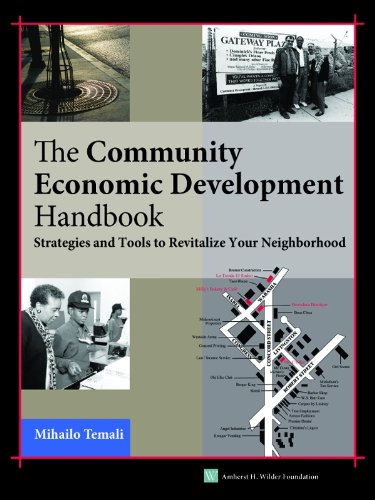Community groups wishing to get involved in economic development are successful when they carefully assess economic conditions and work on one carefully chosen pivot point. After initial successes and evidence of repeated, sustainable success, groups can move on to another pivot points while maintaining efforts on their initial choice.
Many community economic development organizations across the United States have grown in size and capacity and are now successful with three or even all four pivot-point strategies. It is inspirational to see the sheer numbers of people, buildings, businesses, and public spaces that they have impacted over the years, and how their communities are stronger and more unified as a result.
In his groundbreaking work The Community Economic Development Handbook, author Mihailo (Mike) Temali identifies four strategies, or “pivot points,” and shows how community-based organizations can turn them into economic engines for family and community impact. These economic pivot points are the community’s
1. Commercial district
2. Microbusinesses
3. Workforce
4. Job opportunities
When the four pivot points are all being addressed effectively, the result is greater than the sum of the parts. New investments coming from within and from outside the community are far greater than the dollars directly spent or leveraged by the community economic development group itself. The combined strategies have a catalytic effect, as the neighborhood exports goods and services and attracts customers from outside its own boundaries. New money comes into the local economy, rather than draining out. The neighborhood successfully rejoins the regional economy.
Most importantly, much of this new investment takes place according to a plan laid out by the community and its community economic development group, thus benefiting existing residents and businesses. The community—not some outside agency or large, disinterested corporation—claims its own success. Thus, the community is better able to sustain that success and build on it.
Table Of Contents:
Chapter 1: Community Economic Development: An Overview
– Two Goals of Community Economic Development
– Your Vehicle to Meet Those Goalsóan Organization
– Four Pivot-Point Strategies
– A Four-Step Process
– Opening Your Toolbox
– Getting the Most from This Book
– Summary
Chapter 2: Develop Your Organization
– Review the Types of Community Economic Development Organizations
– Handle Basic Start-up Tasks
– Establish Basic Operating Principles
– Build Your Funding
– Build Your Staff
– Develop and Maintain Strong Relationships
– Create Effective Partnerships
– Gain Visibility and Credibility
– Summary
Chapter 3: Pick a Pivot Point and Get Started
– Assess Current Economic Conditions
– Assess Your Organization’s Resources
– Choose a Pivot-Point Strategy
– Tips for Creating Your Vision and Strategic Plan
– Tips for Implementing Your Plan
– Tips for Evaluating and Improving Your Work
– Summary
Chapter 4: Revitalize Your Commercial District
– Overview
– Forces That Drive Districts Down
– The Case for Revitalizing Your Commercial District
– Step 1: Assess Current Conditions
– Step 2: Create a Vision and Strategic Plan
– Step 3: Implement Your Plan
– Step 4: Monitor, Evaluate, and Improve
– Summary
Chapter 5: Develop Microbusiness
– Overview
– Three Reasons to See Microbusiness as an Economic Pivot Point
– Understand Microentrepreneurs
– Step 1: Assess Current Conditions
– Step 2: Create a Vision and Strategic Plan
– Step 3: Implement Your Plan
– Step 4: Monitor, Evaluate, and Improve
– Summary
Chapter 6: Develop Your Community Workforce
– Overview
– Understand the Workforce Development Industry
– Common Elements in Workforce Development Programs
– Seven Common Approaches to Workforce Development
– Step 1: Assess Current Conditions
– Step 2: Create a Vision and Strategic Plan
– Step 3: Implement Your Plan
– Step 4: Monitor, Evaluate, and Improve
– Summary
Chapter 7: Grow Good Neighborhood Jobs
– Overview
– Examples of Neighborhoods Growing Good Jobs
– Pre-assessment: Define the Features of a Job-Producing Business
– Step 1: Assess Current Conditions
– Step 2: Create a Vision and Strategic Plan
– Step 3: Implement Your Plan
– Step 4: Monitor, Evaluate, and Improve
– Summary
Conclusion
Appendices
Index
From “Tools You Can Use” E-newsletter. Copyright Fieldstone Alliance (formerly Wilder Publishing Center). All rights reserved. Sign-up for “Tools” at www.FieldstoneAlliance.org and get free management tips every two weeks.





